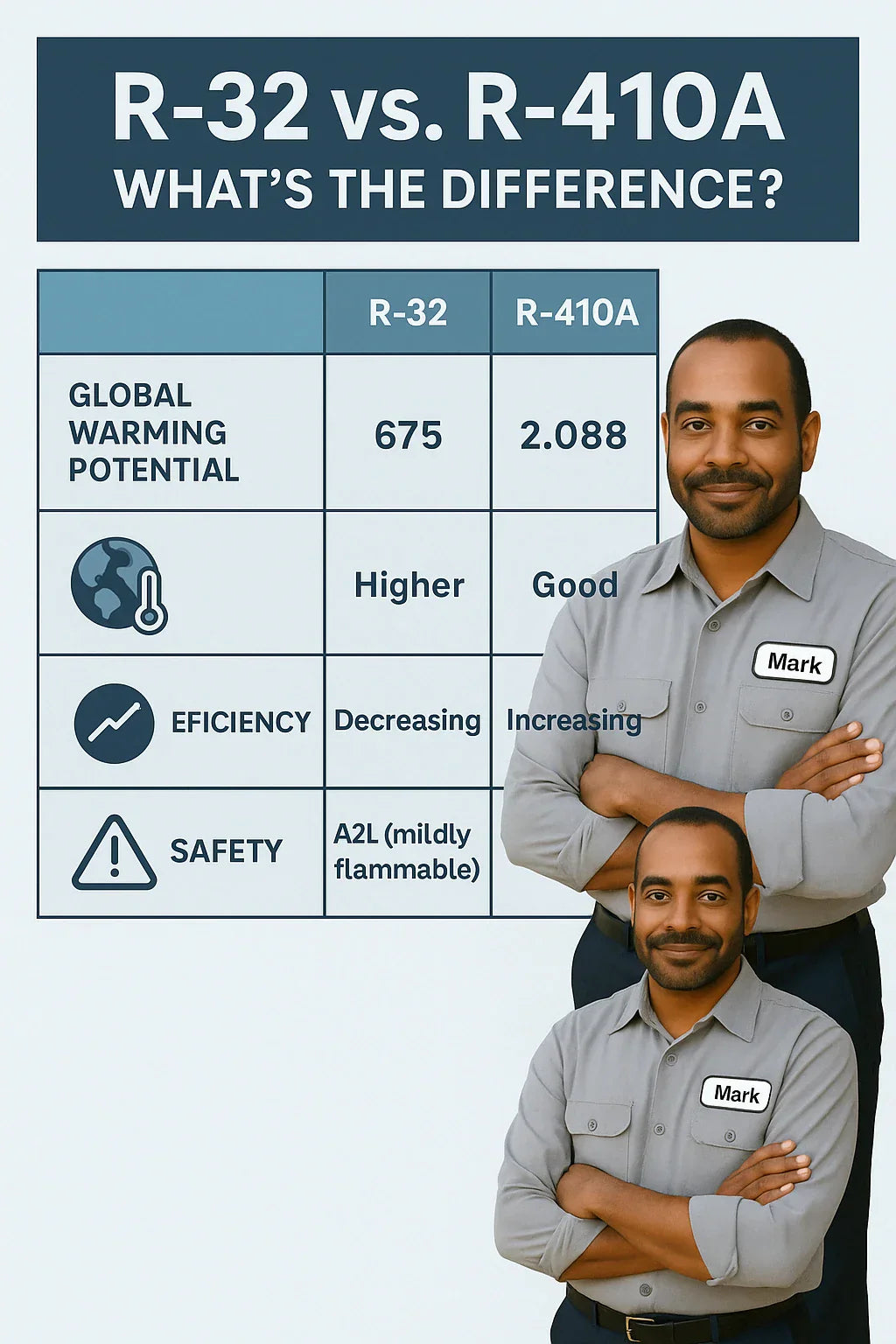🏠 Introduction: The Big Shift in Refrigerants
I’ve been in the HVAC trade long enough to see refrigerants come and go. First, we said goodbye to R-22 (Freon) when the EPA phased it out. Now, it’s R-410A’s turn.
If you’ve been shopping for a new gas furnace or air conditioner lately, you’ve probably seen R-32 listed as the refrigerant. And maybe you’re wondering:
👉 “Why does this matter for me as a homeowner?”
👉 “Is R-32 just another industry gimmick?”
The truth is, this isn’t just a technical detail buried in the spec sheet. The switch from R-410A to R-32 is one of the most important shifts in heating and cooling we’ve had in years. It affects efficiency, environmental impact, safety, and the long-term value of your system.
Today, I’m going to break it down for you in plain English — installer style.
🌍 What Exactly Is R-32?
Let’s start with the basics.
-
R-32 (difluoromethane) is a single-component refrigerant.
-
R-410A is actually a blend of two refrigerants: R-32 and R-125.
Here’s why that matters:
-
R-32 has a lower Global Warming Potential (GWP) — about 675.
-
R-410A has a GWP of around 2,088 (three times higher).
-
R-32 is more energy-efficient in transferring heat.
That means furnaces and AC systems using R-32 can be smaller, lighter, and more efficient.
📖 Reference: EPA – Transitioning to Low-GWP Refrigerants
⚖️ R-32 vs. R-410A: Side-by-Side Comparison
| Feature | R-410A | R-32 |
|---|---|---|
| GWP (Environmental Impact) | ~2,088 | ~675 |
| Efficiency | Good | Higher |
| Composition | Blend (R-32 + R-125) | Single-component |
| Safety | A1 (non-flammable) | A2L (mildly flammable, but safe when handled correctly) |
| Availability | Being phased out | Growing globally |
| Long-Term Viability | Ending in 2025 | Future standard |
👉 Bottom line: R-32 performs better, is easier to recycle, and has less environmental impact.
📖 Reference: Daikin – Why R-32?
⚡ Efficiency Gains: What You’ll Actually Notice
Now, let me answer the question most homeowners really care about: what’s in it for me?
With R-32 furnaces and ACs, you’ll see:
-
Lower energy bills thanks to better heat transfer efficiency.
-
Faster heating and cooling response times.
-
Smaller equipment footprints (manufacturers can design more compact coils and heat exchangers).
-
Reduced wear and tear because the system doesn’t have to work as hard.
In my installs, customers switching from R-410A to R-32 report noticeable improvements in comfort and steady temperatures — especially in smaller homes that use 40,000 BTU furnaces.
📖 Reference: ENERGY STAR – Guide to Efficient Heating
🛡️ The Environmental & Regulatory Push
Why is this change happening now? Two big reasons:
-
EPA AIM Act
-
The U.S. is reducing the use of high-GWP HFCs like R-410A.
-
By 2025, new residential HVAC systems must use lower-GWP refrigerants.
-
-
Global Regulations
-
The Kigali Amendment to the Montreal Protocol requires countries worldwide to cut HFC emissions.
-
Europe and Asia have already widely adopted R-32.
-
So, if you’re buying a furnace today, you’re essentially choosing between:
-
Yesterday’s refrigerant (R-410A, which will be harder to service over time).
-
Tomorrow’s refrigerant (R-32, which is already becoming the new standard).
📖 Reference: EPA – Phasedown of Hydrofluorocarbons (HFCs)
🔧 Installation & Service: What I Look For as an Installer
Now, let’s talk shop. From the installer side, R-32 changes a few things:
-
Slight Flammability
-
R-32 is classified A2L (“mildly flammable”).
-
Don’t let that scare you — it’s safe when installed and maintained correctly.
-
I use equipment specifically rated for A2L refrigerants.
-
-
Training & Tools
-
Technicians need R-32 certification training.
-
Service tools (like gauges and recovery machines) are slightly different.
-
-
Maintenance
-
Because R-32 is a single-component refrigerant, it’s easier to recover, recycle, and recharge compared to blended refrigerants like R-410A.
-
From my perspective, once you’ve got the right tools and training, R-32 is actually simpler to work with than R-410A.
📖 Reference: ASHRAE – Refrigerant Safety Classification
💵 Cost & Long-Term Ownership
Here’s where homeowners perk up — money talk.
-
Upfront Cost
-
R-32 furnaces may cost slightly more right now because they’re newer to the U.S. market.
-
-
Energy Savings
-
Expect lower utility bills (5–10% savings depending on your usage and home).
-
-
Service & Parts Availability
-
R-410A will become harder to find (and more expensive) after 2025.
-
R-32 will be widely available, just like R-410A was 10 years ago.
-
So yes, you might pay a bit more up front, but you’ll save on bills and avoid service headaches down the road.
📖 Reference: Furnace Installation Costs
🔍 Real-World Examples: R-32 in Action
Here are some installs where I saw R-32 shine:
-
Compact Homes (1,200–1,600 sq. ft.)
-
Paired a 40,000 BTU R-32 furnace with efficient ductwork.
-
Result: Lower bills and more even heating.
-
-
Townhouses with Limited Closet Space
-
R-32 systems allowed me to install a smaller footprint furnace.
-
No more awkward utility closet squeezes.
-
-
Eco-Conscious Homeowners
-
Customers looking for green upgrades love the low-GWP refrigerant choice.
-
🏆 Mark’s Take: Why This Matters to You
Let me cut through the jargon.
-
R-410A is on its way out.
-
R-32 is here to stay.
-
Choosing R-32 today means:
-
✅ Lower bills
-
✅ Better efficiency
-
✅ Environmental responsibility
-
✅ Fewer service headaches in 5–10 years
-
👉 If you’re buying a new furnace in 2025, don’t lock yourself into yesterday’s refrigerant.
From one installer to a homeowner: R-32 is the smart move.
🎨 Infographic Idea
“R-32 vs. R-410A: The Future of Refrigerants”
-
Column chart with:
-
GWP comparison
-
Efficiency difference
-
Cost trend
-
Safety rating
-







